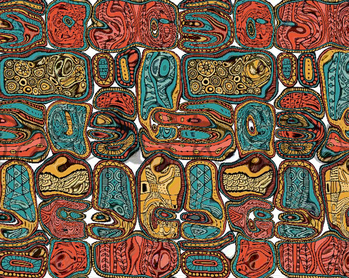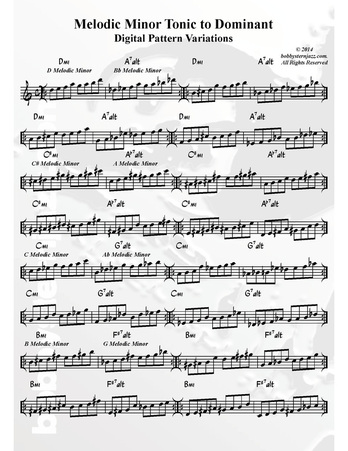Got the Digits?
Melodic Minor Tonic to Dominant (i-V7alt) Digital Patterns
 "Dig It All! Re: Doo-Doo" painting by Fo-Toh Zjiap
"Dig It All! Re: Doo-Doo" painting by Fo-Toh Zjiap This exercise is a technical study in the use of inherent Melodic Minor "1235 type" "digital patterns" over a common Tonic to Dominant (i - V7alt) harmonic movement, aka the "A" sections of "Softly as in a Morning Sunrise", or "A Night in Tunisia" (which has a bII7 sub for its V7).
By "digital patterns", I don't mean "ones and zeros" or Boolean Algebra; just good ol' analog left and right hand "digits", more commonly known as fingers.
While one might be familiar with the common Major Scale "digits" (ie, 1235 4568, 2346 5679 and so forth), the altered Melodic Minor versions of these same patterns might be less familiar, both in feel as well as sound.
The downloadable exercise is designed to familiarize oneself with these Melodic Minor "altered" digital patterns.
The basic scheme, with exceptions, is step up - step up - skip up / step down - step up - step up -skip up.
Line #1, Measure #1 - (D min) D-E-F-A / G-A-B-D = scale steps 1-2-b3-5 / 4-5-6-8 of D Melodic Minor, right? Solid!
Line #1, Measure #2 - (A7alt) Db-Eb-F-A / G-A-Bb-Db = scale steps b3-4-5-7 / 6-7-8-b3 of Bb Melodic Minor, which is the parent scale from which the "A altered" scale is begat, being born on its 7th degree ("....it's the one, it's the one; the one they call the Seventh Son").
Maybe they should call this the "Hoochie Coochie" scale!
But seriously, folks........
By beginning the second measure pattern on a Db (C#), we're employing the next closest descending scale tone to the first note of measure #1, which was D. The Db (C#) is the Maj 3rd of A7alt chord, as well as the b3 of Bb Melodic Minor.
Well, you ask, shouldn't you be thinking Db (or C#) Lydian Augmented (the mode built off the 3rd scale degree of Bb Melodic Minor)?
No, not really.
The fact that Melodic Minor contains no "avoid notes", means that you can start the scale on any of its notes. It doesn't matter what you call it, because in this case, you're expressing Bb Melodic Minor over A. Why tax your brain with a bunch of names.
The modes of Melodic Minor are useful to know and understand if you are using them "modally".
That is, when improvising over a static harmonic situation lasting several measures or more. In that case, if you're vamping over a Db for say, 8 or 16 bars, you might think, "Hey, Db Lydian Augmented!".
However, I still think it's much simpler, even then, to think in terms of the Melodic Minor parent scale or "key"; Bb Melodic Minor over Db, in this case
The remainder of the exercise follows along the same basic scheme; although not all 4 note groupings are symmetrical, as well as several note combinations have been left out.
For example, both Line #1, Measure #3 and Line #2, Measure #2 employ a basic1-2-3-6 / 5-6-7-8 (counting the first note of that measure as "1"), which translate to
step up - step up - skip 2 steps up / step down - step up - step up -step up
= B-C#-D-G / F-G-A-B and G-A-Bb-Eb / Db-Eb-F-G, respectively.
Each measure ends a perfect octave higher than the note from which it started.

 RSS Feed
RSS Feed








